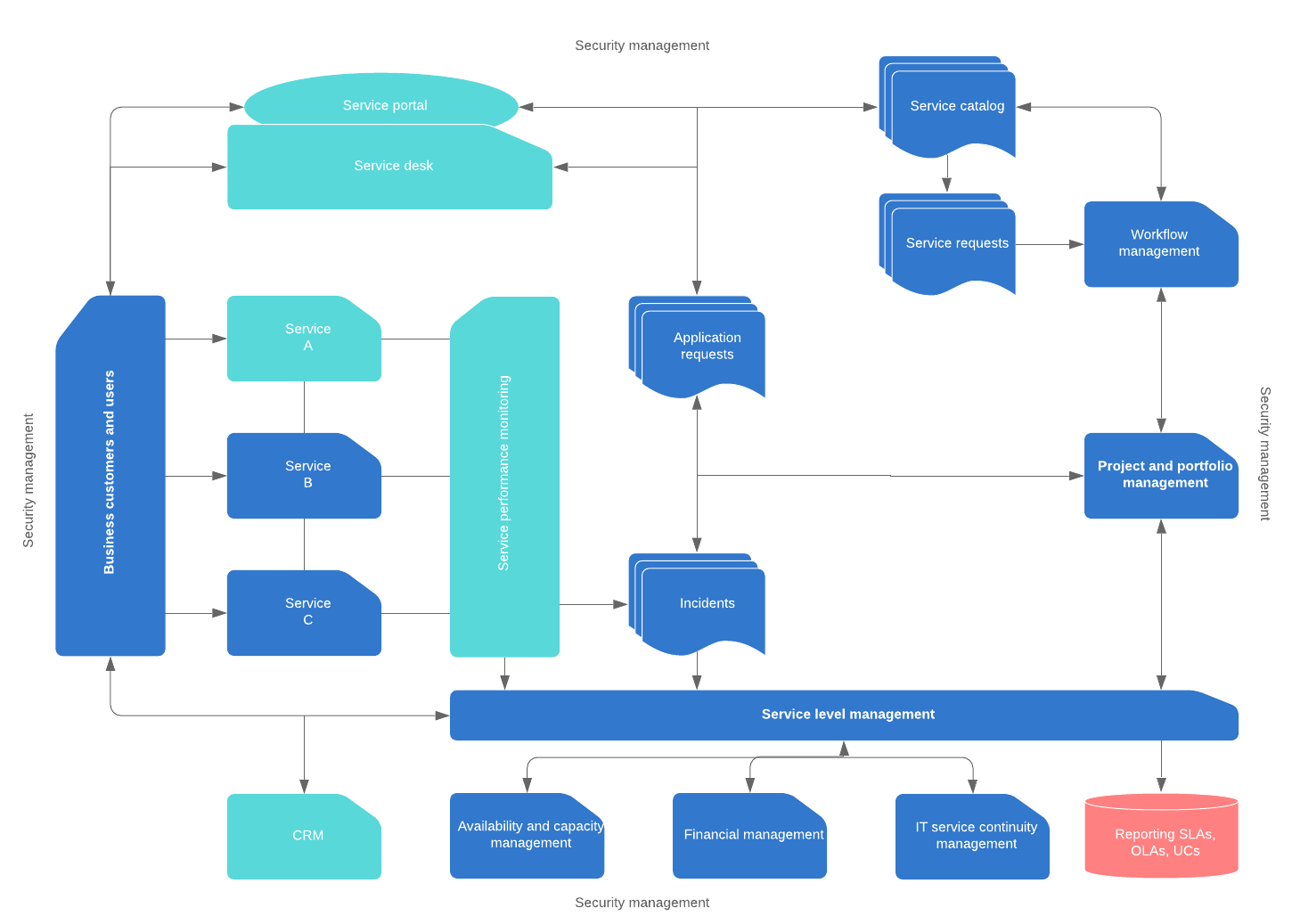
ITIL Best Practices: Knowledge Management
Lucid Content
Reading time: about 9 min
Topics:
Crucial in an ITIL framework, knowledge management allows teams and companies to collect and share information so everyone is on the same page. Without it, employees waste time looking up or recreating information that already exists, resulting in frustrated customers and higher operating costs.
So how can you implement better ITIL knowledge management processes in your organization?
What is knowledge management?
Essentially, knowledge management is the collection, analysis, storage, and sharing of the total body of information within an organization, from strategy to improvement. This knowledge includes not only processes and systems, but also staff skills, user behavior, organizational structure, supplier information, and much more.
You shouldn’t just do this because it sounds like a neat and organized way to manage your business. Knowledge management at its core is about creating value––you gather all this information because it makes you a better, more profitable company.
In an ITIL process, teams need to access reliable information, ideally from a service knowledge management system (SKMS), to effectively implement services. A clear knowledge management process ensures the efficient transfer of that information to the right people at the right time.

Origins of knowledge management
Knowledge management practices have existed for a long time––corporate libraries, mentoring programs, apprenticeships, and the like. Not surprisingly, knowledge management became more established with the rise of the Internet and globalization.
The birth and subsequent growth of the World Wide Web made it much easier to share all that knowledge that previously might have only existed internally. Globalization, on the other hand, put a premium on recording and disseminating knowledge to speed up production and innovation, particularly in IT.
Who uses knowledge management?
While ITIL knowledge management specifically applies to service management and service desk employees, the answer to this question really should be everyone! Any company, whether it’s your local dentist office or a service provider, relies on internal knowledge to operate their business and will likely have some customer-facing content to build customer engagement and trust, even if it’s just an FAQ page.
Without proper knowledge management, you’re not capitalizing on your employees’ experience, you make it harder for them to do their jobs well, and you spread that burden onto your customers as well.
Purpose of knowledge management
A successful SKMS, or any knowledge management system, for that matter, is more than just about storing data. To truly work as a platform for knowledge, it should increase learning and collaboration among employees, breaking down costly and inefficient siloes that so often crop up in larger organizations.
Components of knowledge management systems
A knowledge management system is simply whatever technological tool or set of tools an organization uses to store and manage knowledge. In an ITIL framework, that is specifically the service knowledge management (SKMS).
Here are the operational components that contribute to a knowledge management system.
Content management system
Essentially, this is where you store your documentation and data. It’s also where you’ll go to find it, so it needs to be easily searchable and be able to handle the vast amounts of content added to it.
Expertise locator system
This is how you search through and find the people inside your own organization who have expertise in certain areas. Perhaps more commonly referred to as an employee directory or skills inventory, it’s a database that helps employees find subject matter experts within the company.
Skills and expertise can range from work experience to technical knowledge and beyond. The more details are searchable, the more knowledge can be shared within the organization.
Lessons learned databases
This database should act as a repository of best practices and expertise learned along the way or knowledge that isn’t obvious or available to others, often referred to as tacit knowledge. The most important thing is to make this database accessible––if it’s not accessible, then those lessons learned won’t get implemented.
Communities of practice (CoPs)
These are groups made up of employees who share common interests and who come together to share that knowledge, in the same spirit of the lessons learned databases––to spread knowledge across an organization. Working at large companies or remotely makes it difficult for employees to come together like this, so you should use a digital solution and decide how these CoPs will be lead, maintained, reviewed, and how the information they gather will be stored.
Benefits of knowledge management
The role of knowledge management is to improve decision-making and customer service across your organization by making accurate and reliable information available throughout the service lifecycle.
There are many benefits to adopting a knowledge management process:
- Increase collaboration among employees. With a shared base of understanding, employees have a formalized, systematic way of trading information between teams, making them more collaborative and keeping them aligned with your overall organizational goals.
- Hold on to valuable knowledge. When employees leave or change positions, they create a potential gap. By implementing a knowledge management process, you can document the often unspoken wisdom employees have about their position.
- Improve employee training programs. When employees have access to your organization’s processes and best practices, they can hit the ground running and reduce hours spent in formal training meetings. Additionally, with one source of truth, your teams work off the same assumptions and information, reducing time-consuming and frustrating inconsistencies.
- Reduce costs. A good SKMS isn’t just for your employees––it also benefits your customers by providing some service information online. This is much cheaper than having service desk employees assist every customer.
- Reduce human errors and increase efficiency. Access to information and formal decision-making processes makes it easy for employees to learn from past mistakes, avoid redundancies, and execute tasks with confidence.
- Scale customer support. When relevant parts of the SKMS are made available in a self-help user portal (or knowledge base), you can scale your customer support efforts, so customers can find the answers they need, and you can focus on solving bigger problems within the service desk to-do list.
- Increase customer satisfaction. Organizations that manage their knowledge base have happier customers because their employees are better trained, more knowledgeable, and more efficient and effective at delivering expected services.
- Focus on growth and innovation. With a single source of truth, your service desk and support staff will know how the service is currently used and which versions are discontinued, for example. If you try to rely on an informal or transitory knowledge base, you can’t guarantee efficiency in customer service or in the use of resources.

Want to increase collaboration and better align your business and service management strategies?
Learn howIssues with knowledge management
In order to fully benefit from a knowledge management system, you need to be aware of the challenges that can crop up along the way.
- Measurability: Knowledge is a hard thing to measure, which also makes it hard to measure the performance or benefits of knowledge management. Some things you could track include your success in implementing an SKMS, whether the number of knowledge-related errors decrease, reduced incident handling time, or increased customer self-service opportunities.
- Participation: Without the proper planning, design, and management, employees won’t feel motivated to share their knowledge. You won’t benefit from knowledge management if no one contributes to it. Your knowledge management process and SKMS should be intuitive and embedded in your employees’ workflow.
- Implementation: Knowledge management is an essentially collaborative, flexible approach to service management. Some employees may not want to follow this new way of doing things. For example, support analysts might think that sharing knowledge will help others resolve errors without them, making their position obsolete. Be sure to frame your in a way that highlights the benefits of knowledge management.
- Dissemination: So you’ve gathered lots of knowledge. Now what? Knowledge management is more than just a storage strategy. That’s just half of the story. Have a process in place for giving your employees and customers access to it.
- Ownership: For an ITIL framework, the answer as to who is in charge of the knowledge management strategy is pretty simple––it’s IT. But if there’s other knowledge management systems that aren’t specific to service management, then you’ll have to determine who will not only manage the knowledge but maintain the learning and sharing of it (a hint: HR is a popular choice).
How to implement knowledge management
A knowledge management system can seem daunting to put in place, but it’s more about capitalizing on and optimizing resources that you already have than it is about upending all your processes.
Follow these steps to put your knowledge management strategy to practice.
1. Identify knowledge that will be useful: Before you decide to just gather any and all information, decide what has the most value. Perform a knowledge gap analysis to find out what your employees need to know to perform their jobs and what they actually know. Other factors to research are commonly asked questions (or search terms) from customers, expertise specific to certain roles that could benefit the rest of the customer service experience, or qualitative data like customer survey results.
2. Design a process for organizing and storing knowledge: Once you decide what you’re going to collect, how will you store it? Where are you going to put it? Who will be in charge of these decisions? Along with these questions, you need to ensure that you have adequate backup and recovery of your knowledge management systems.
3. Make your knowledge management system accessible: The knowledge you’re collecting should be easily accessible and helpful, but people learn in a variety of ways. Your knowledge base should reflect that. Consider using:
- Diagrams (e.g., process diagrams to clarify what employees should do, or technical diagrams and graphics to help customers understand your services)
- Tutorial videos
- Webinars
- Graphics
- Images
- Newsletters
4. Audit and update your knowledge: Knowledge management is unfortunately not a “one-and-done” process. It should always be ongoing, meaning that you should measure how the information you’ve collected gets used, evaluate its effectiveness and relevance, and identify anything that isn’t useful anymore.
With a robust ITIL knowledge management system, you’ll be able to make your customers happier, answer their questions more quickly and efficiently, and help them be more successful with your services.
Your employees win, too––by documenting and sharing their experiences, you’ll foster collaboration, alleviate frustration, and ensure that best practices are adopted across your teams.

Implement ITIL best practices, optimize your IT service management processes, and collaborate across teams with Lucidchart.
Learn moreAbout Lucidchart
Lucidchart, a cloud-based intelligent diagramming application, is a core component of Lucid Software's Visual Collaboration Suite. This intuitive, cloud-based solution empowers teams to collaborate in real-time to build flowcharts, mockups, UML diagrams, customer journey maps, and more. Lucidchart propels teams forward to build the future faster. Lucid is proud to serve top businesses around the world, including customers such as Google, GE, and NBC Universal, and 99% of the Fortune 500. Lucid partners with industry leaders, including Google, Atlassian, and Microsoft. Since its founding, Lucid has received numerous awards for its products, business, and workplace culture. For more information, visit lucidchart.com.
Related articles
How to Implement a Successful ITIL Incident Management Process
Incident management plays a vital role in the day-to-day operations of organizations large and small. To ensure your IT support team is most effective, implement a clear process flow from the incident report to resolution.
Webinar Recap: How to Apply Performance Metrics to Business Processes
Read the recap of our webinar with Jogee Varughese, a business process consultant for Austin Energy. Jogee discussed how you can measure continuous improvement work at your company.
